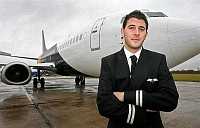(Career Options) Careers in Commercial Pilot
Disclaimer: This website is NOT associated with CBSE, for official website of CBSE visit - www.cbse.gov.in
Careers in Commercial Pilot
 The
job of commercial pilot is the most glamorous and exciting job in aviation. It
is highly rated and one of the most adventurous career which requires intensive
training. This profession also demands a lot of time, dedication, patience and
sacrifice. A career in aviation attracts many youngsters as it provide
opportunity to travel around the globe. This is a lucrative field. But apart
from all those attractive things the job of a commercial pilot makes him
responsible for the aircraft he flies and the lives of his passengers.
The
job of commercial pilot is the most glamorous and exciting job in aviation. It
is highly rated and one of the most adventurous career which requires intensive
training. This profession also demands a lot of time, dedication, patience and
sacrifice. A career in aviation attracts many youngsters as it provide
opportunity to travel around the globe. This is a lucrative field. But apart
from all those attractive things the job of a commercial pilot makes him
responsible for the aircraft he flies and the lives of his passengers.
The most important person on an aircraft is the pilot. Pilots are highly trained
professionals who fly airplanes and helicopters carrying passengers or cargo.
This is a highly specialised job which requires knowledge of air navigation,
interpretation of meteorological reports, operations of sophisticated electronic
and mechanical controls, leading the aircraft under adverse circumstances, and
being a leader to the flight crew and passengers under climatic and other
emergency situations.
There are a number of institutes under the recognition of the Directorate
General Of Civil Aviation which conducts training in this field. Most prominent
among them is Indira Gandhi Rashtriya Academy at Rae Bareli (Uttar Pradesh).
Other major training centres are flying clubs at Mumbai and Delhi.
Eligibility
Educational: To become a commercial pilot in India, one ha s to first possess a Student Pilot License (SPL). To get the SPL those with 10+2 with science and aged at least 16 years should register at a flying club which is recognized by Directorate General of Civil Aviation (DGCA), Government of India. Registration requires a medical certificate, security clearance and a bank guarantee. An oral examination in subjects such as Air Regulations, Aviation Meteorology, Air Navigation, Engine (technical and specific) follows the registration. Successful completion of the examination entitles you for an SPL certificate.
The second step is the Private Pilot License (PPL). PPL training includes sixty hours of flying of which about fifteen hours are dual flights, that is accompanied by the flight instructor and at least 30 hours of solo flights apart from five hours of cross-country flying. This makes one eligible for the PPL exam, which consists of Air Regulation, Aviation Meteorology, Air Navigation, Aircraft Engines and Seamanship. The prescribed age for appearing for this exam is 17 years and an educational qualification of 10+2 along with a medical Fitness Certificate issued by the Armed Forces Central Medical Establishment (AFCME).
A Commercial Pilot Licence may be obtained only after a PPL has been acquired. To obtain a Commercial Pilots License (CPL) 250 hours of flying (including 60 hours for the PPL) is necessary. Besides that you have to undergo a Medical Fitness Test which is held at New Delhi and an examination which consists of Air Regulations, Aviation Meteorology, Air Navigation, Technical, Planning, and communications in the form of Radio & Wireless Transmission. With the CPL, a pilot can take up any professional assignment.
Personal Attributes: This is a filed of discipline, patience, responsibility, punctuality, commitment and self-confidence. The job requires a lot of hard work, stamina, alertness of mind, adaptability to follow difficult time schedules, good team spirit etc. Must be mentally very alert in every situation. Emotional stability in crisis situations is another characteristic that the pilots should have. Apart from these qualities, the persons willing to take up this as profession, should be calm, pleasant, compassionate, adventurous, understanding and technically sound.
Job Prospects and Career Options
Job Prospects
With the privatisation, lot of avenues have opened for CPL holders. They can find employment opportunities in both government (Indian Airlines, Air India) as well as private domestic and international (Jet Airways, Sahara etc.) airlines. Even large corporate houses with their own aircraft require the services of pilots.
Career options
In this field after getting CPL one start as a trainee pilot. After being a trainee, one becomes a pilot or first officer on board based on ones seniority. Seniority is determined by hours of flying experience and successful completion of various programs. Then one becomes a Commander or Captain and thereafter a Senior Commander.
From pre-take off to actual landing and signing off, pilot must be highly responsible. Before take-off pilots check pre-flight plans. These includes the route to be taken and height maintained, meteorological readings, conditions of all equipments, air pressure and temperature inside the aircraft etc. They have to do complex calculations of take-off and landing and have to check fuel needed for the particular distance to be traveled and height and weight to be maintained. During the flight too pilot must be constantly alert, ensuring there are no mechanical snags, maintaining contact with air traffic controls and cabin crew through-out the flight. He also has to keep a record of flight details.
Remuneration
Pay scales of commercial pilots in the public sector organizations depend on the grade level of the positions. They will get attractive remuneration and incentives. The total remuneration also includes contributory provident fund, gratuity, medical facilities and free/concessional air passage. Pilots are also entitled to a range of benefits and allowances in addition to housing, medical and out- station allowances, as well as free/concessional air passages for their immediate family and dependants. Commercial pilots can earn from Rs. 40,000 to Rs. 150,000 per month, depending on the airline and one's experience.